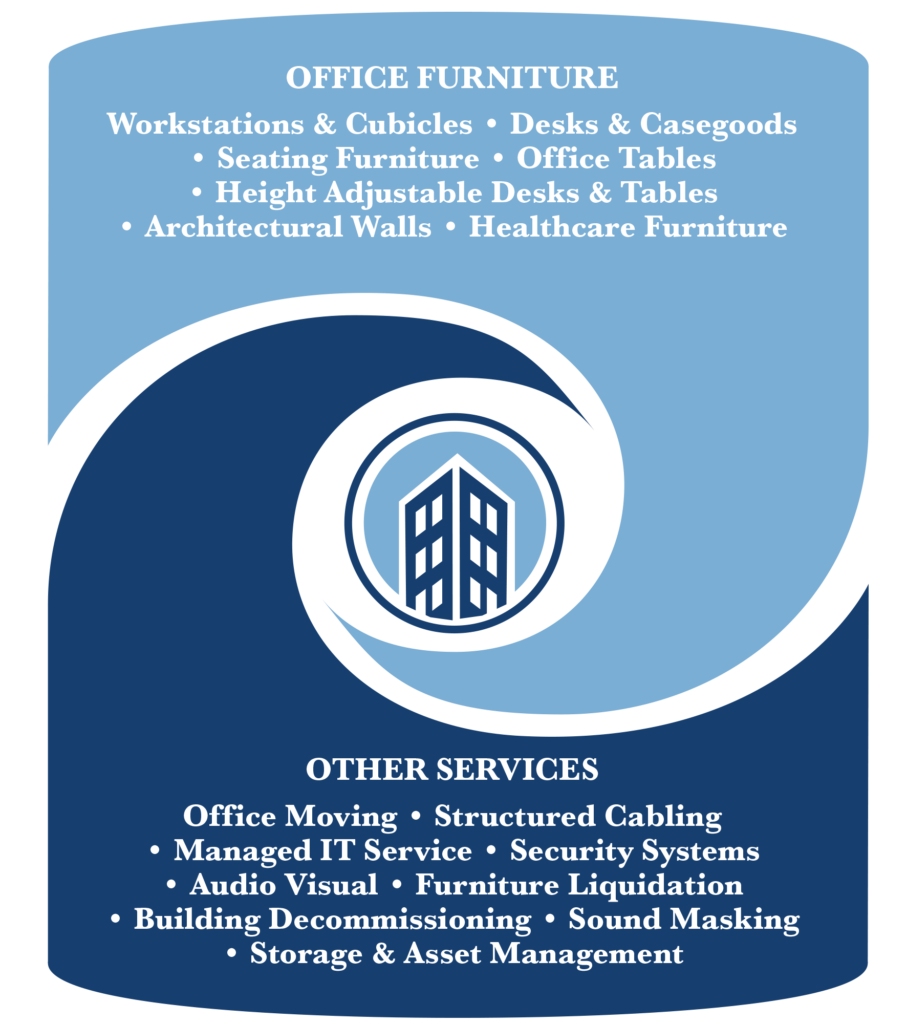22 Nov Introduction to Hybrid Work Trends
As the world emerges from the shadows of the COVID-19 pandemic, the way we work has undergone a seismic shift. Traditional office environments are being reimagined, and hybrid work models are rapidly gaining traction. It is estimated that 71% of US businesses accommodate a hybrid work model as of 2023 and 29% plan to make that model permanent. (BRB Reviews – Hybrid Work Statistics) This transformative approach blends the best of both worlds – the flexibility of remote work and the collaborative energy of in-office interactions. Embracing hybrid work trends is not just a passing fad; it’s a strategic move that can unlock new levels of productivity, employee satisfaction, and organizational success.
In this article, we’ll delve into the intricacies of hybrid work trends, exploring their benefits, challenges, and practical strategies for creating a productive office space that caters to the evolving needs of modern workforces. Buckle up as we navigate the future of work and uncover the secrets to thriving in this dynamic landscape.

Understanding the Concept of Hybrid Work
Hybrid work, also known as hybrid working or hybrid workplace, is a flexible arrangement that combines remote work with in-office presence. Employees are given the autonomy to independently choose where they work. Whether from home, a coworking space, or the traditional office setting, they choose based upon their preference and job requirements.
This model challenges the traditional 9-to-5 office routine. It empowers employees to strike a balance between their professional and personal lives. By embracing hybrid work trends, organizations can achieve benefits less available in the traditional model. They can tap into a wider talent pool, reduce overhead costs associated with maintaining large office spaces designed to accommodate all headcount, and foster a more engaged and satisfied workforce.
Five Benefits of Embracing Hybrid Work Trends
 Adopting hybrid work trends can yield numerous benefits for both employees and organizations. Here are some compelling advantages:
Adopting hybrid work trends can yield numerous benefits for both employees and organizations. Here are some compelling advantages:
- Increased Productivity: Studies have shown that remote workers often experience higher levels of productivity due to fewer distractions and commuting time. Additionally, the flexibility to work during peak energy hours can boost overall output.
- Improved Work-Life Balance: Employees can eliminate daily commutes and create more flexible schedules. In turn, this creates better balance in their professional and personal responsibilities. The result…higher job satisfaction and reduced burnout.
- Talent Acquisition and Retention: Offering hybrid work options can help organizations attract and retain top talent, especially in competitive job markets. It demonstrates a commitment to employee well-being and a progressive company culture.
- Cost Savings: With a reduced need for large office spaces and associated overhead costs, organizations can reallocate resources more efficiently.
- Environmental Benefits: Fewer commuters on the road translates to reduced emissions and a smaller environmental footprint.
Challenges of Implementing Hybrid Work
While the benefits of hybrid work trends are compelling, implementing this model is not without its challenges. Organizations must be prepared to address potential hurdles, such as:
- Communication and Collaboration Barriers: Maintaining effective communication and collaboration between remote and in-office teams can be challenging, requiring intentional strategies and the right tools.
- Technology Infrastructure: Ensuring secure and reliable technology infrastructure to support remote work is crucial. This can include robust video conferencing capabilities, cloud-based file sharing, and cybersecurity measures.
- Workplace Culture and Engagement: Fostering a strong company culture and maintaining employee engagement can be more challenging in a hybrid environment, requiring intentional efforts to promote inclusivity and a sense of belonging.
- Management and Monitoring: Effectively managing and monitoring remote teams requires trust, clear performance metrics, and adaptable leadership styles.
- Cybersecurity Risks: With more employees accessing company data and systems remotely, organizations must implement robust cybersecurity measures to mitigate potential risks.
Furniture Changes to Consider for Supporting Hybrid Work
 To create a productive and engaging office space that supports hybrid work trends, organizations may need to rethink their furniture and space design. Here are some key considerations:
To create a productive and engaging office space that supports hybrid work trends, organizations may need to rethink their furniture and space design. Here are some key considerations:
- Flexible and Modular Workstations: Opt for modular and reconfigurable workstations that can adapt to changing team dynamics and workspace needs. This allows for easy rearrangement and personalization.
- Collaborative Spaces: Incorporate dedicated collaborative spaces, such as huddle rooms, project rooms, and open meeting areas. These areas facilitate in-person brainstorming and team interactions.
- Quiet Zones and Focus Rooms: Provide quiet zones or focus rooms for employees who need distraction-free environments for deep work or virtual meetings.
- Ergonomic Furniture: Invest in ergonomic furniture, such as adjustable desks and chairs. Promoting proper posture to reduce the risk of musculoskeletal disorders is beneficial in the office and at home.
- Biophilic Design Elements: Incorporate biophilic design elements, such as natural lighting, indoor plants, and nature-inspired materials. Creating a calming and rejuvenating work environment is a benefit whether hybrid work is supported or not.
Strategies for Creating a Productive Office Space for Hybrid Work
 Designing an office space that supports hybrid work trends requires a strategic approach. Here are some effective strategies to consider:
Designing an office space that supports hybrid work trends requires a strategic approach. Here are some effective strategies to consider:
- Conduct Workspace Assessments: Assess your current office space and identify areas that may need reconfiguration or redesign to accommodate hybrid work needs. Involve employees in the process to gather their insights and preferences.
- Implement Activity-Based Working: Adopt an activity-based working model, where different zones are dedicated to specific tasks or activities. These areas could support collaborative work, focused work, or informal meetings.
- Leverage Technology and Automation: Integrate technology solutions like room booking systems, occupancy sensors, and automated lighting and temperature controls to optimize space utilization and energy efficiency.
- Promote Workplace Flexibility: Encourage employees to use the office space in a flexible manner. Allow them to choose the most suitable environment for their tasks and preferences on any given day.
- Foster a Collaborative Culture: Create opportunities for in-person collaboration and team-building activities. Seek to maintain a sense of community and foster strong working relationships within hybrid teams.
Technology Solutions for Supporting Hybrid Work
Embracing hybrid work trends requires robust technology solutions to enable seamless communication, collaboration, and productivity. Here are some essential tools and technologies to consider:
- Video Conferencing Platforms: Invest in reliable and user-friendly video conferencing platforms. Platforms like Zoom, Microsoft Teams, or Google Meet facilitate virtual meetings, presentations, and real-time collaboration.
- Cloud-Based File Sharing and Storage: Leverage cloud-based file sharing and storage solutions like Google Drive, OneDrive, or Dropbox. Ensure secure and seamless access to documents and files for both remote and in-office employees.
- Project Management and Collaboration Tools: Implement project management and collaboration tools like Trello, Asana, or Slack. These platforms streamline workflows, assign tasks, and facilitate real-time communication among hybrid teams.
- Virtual Whiteboards and Ideation Tools: Utilize virtual whiteboards and ideation tools. Miro or Mural are good examples that enable remote brainstorming, ideation, and visual collaboration sessions.
- Cybersecurity Solutions: Invest in robust cybersecurity solutions, such as virtual private networks (VPNs), multi-factor authentication, and endpoint protection, to safeguard sensitive data and ensure secure remote access.
Five Best Practices for Managing Remote and In-person Teams
 Effectively managing hybrid teams requires a combination of clear communication, trust, and adaptable leadership strategies. Here are some best practices to consider:
Effectively managing hybrid teams requires a combination of clear communication, trust, and adaptable leadership strategies. Here are some best practices to consider:
- Establish Clear Communication Protocols: Define clear communication protocols and expectations for both remote and in-office employees. Ensure the requirement is understood for regular check-ins, virtual team meetings, and response timelines.
- Foster a Culture of Trust and Accountability: Cultivate a culture of trust and accountability by setting clear goals, providing autonomy, and focusing on results rather than micromanaging processes.
- Encourage Collaboration and Knowledge Sharing: Create opportunities for remote and in-office employees to collaborate and share knowledge. This includes virtual team-building activities, cross-functional projects, or knowledge-sharing sessions.
- Provide Ongoing Training and Support: Offer training and support resources to help employees adapt to hybrid work tools and best practices. Ensuring they have the necessary skills and resources to thrive is the path to success.
- Prioritize Inclusivity and Equity: Ensure that both remote and in-office employees have equal access to opportunities, resources, and decision-making processes.
Maintaining Work-life Balance in a Hybrid Work Environment
 While hybrid work offers flexibility and autonomy, it can also blur the lines between work and personal life. Maintaining a healthy work-life balance is crucial for employee well-being and productivity. Here are some strategies to consider:
While hybrid work offers flexibility and autonomy, it can also blur the lines between work and personal life. Maintaining a healthy work-life balance is crucial for employee well-being and productivity. Here are some strategies to consider:
- Set Boundaries and Establish Routines: Encourage employees to set clear boundaries between work and personal time, establish daily routines, and respect each other’s schedules and availability.
- Promote Digital Detox and Mindfulness: Encourage regular digital detox periods and mindfulness practices to help employees disconnect from work and recharge their mental and physical energy.
- Offer Wellness Programs and Resources: Provide access to wellness programs, such as virtual fitness classes, mental health resources, or employee assistance programs, to support overall well-being.
- Lead by Example: As a leader, model healthy work-life balance behaviors, such as taking breaks, disconnecting during non-work hours, and prioritizing self-care.
- Encourage Vacation Time and Breaks: Actively encourage employees to take vacation time and regular breaks to prevent burnout and promote work-life harmony.
Future Predictions and Trends in Hybrid Work
As hybrid work continues to evolve, it’s essential to stay informed about emerging trends and predictions. Here are some potential developments to watch for:
- Increased Adoption of Hybrid Work Models: Experts predict that hybrid work models will become the norm across various industries, driven by employee demand for flexibility and organizations’ desire for cost savings and talent retention.
- Rise of Hybrid Office Designs: Office spaces will continue to adapt to hybrid work needs, with more flexible, modular, and activity-based designs that cater to diverse work styles and preferences.
- Advancements in Virtual Collaboration Tools: Technological innovations in virtual collaboration tools, such as augmented reality (AR) and virtual reality (VR), may enhance remote collaboration experiences and bridge the gap between physical and virtual workspaces.
- Emphasis on Employee Well-being: Organizations will place greater emphasis on employee well-being, offering more comprehensive wellness programs, mental health resources, and initiatives to promote work-life balance in hybrid environments.
- Hybrid Work Policies and Regulations: As hybrid work becomes more prevalent, governments and regulatory bodies may introduce new policies and guidelines to address issues related to remote work, data privacy, and employee rights.
Conclusion: Embracing the Future of Work with Hybrid Work Trends
The future of work is here, and hybrid work trends are at the forefront of this transformation. By embracing this model, organizations can unlock new levels of productivity, attract and retain top talent, and foster a more engaged and satisfied workforce.
However, successfully navigating the hybrid work landscape requires a strategic approach. Success means addressing potential challenges, and implementing the right tools, technologies, and best practices. From redesigning office spaces to fostering a culture of trust and collaboration, organizations must be proactive in adapting to this new paradigm.
As we move forward, it’s essential to remain agile and open to emerging trends and innovations in the hybrid work space. By embracing the future of work, organizations can position themselves for long-term success in an ever-evolving business landscape.
(Images Sourced from Pexels, Unsplash and Global Furniture Group)
Are you ready to embrace the future of work and unlock the full potential of hybrid work trends? Our forward-thinking professionals are adept at tailored solutions for creating a thriving hybrid work environment. Contact our team of office furniture experts today to learn how we can help you navigate these concerns.
MyOffice has over 20 years of experience in supporting client’s implementing office solutions. We understand the needs of the modern office environment. Optimizing your workspace through furniture selection and layout is a core competency of ours. We are here to help!

